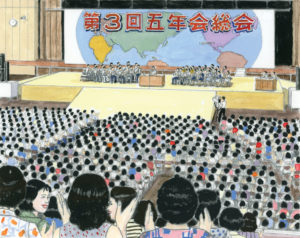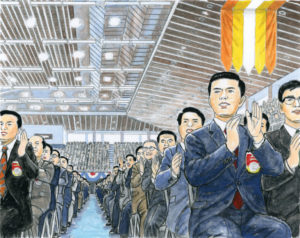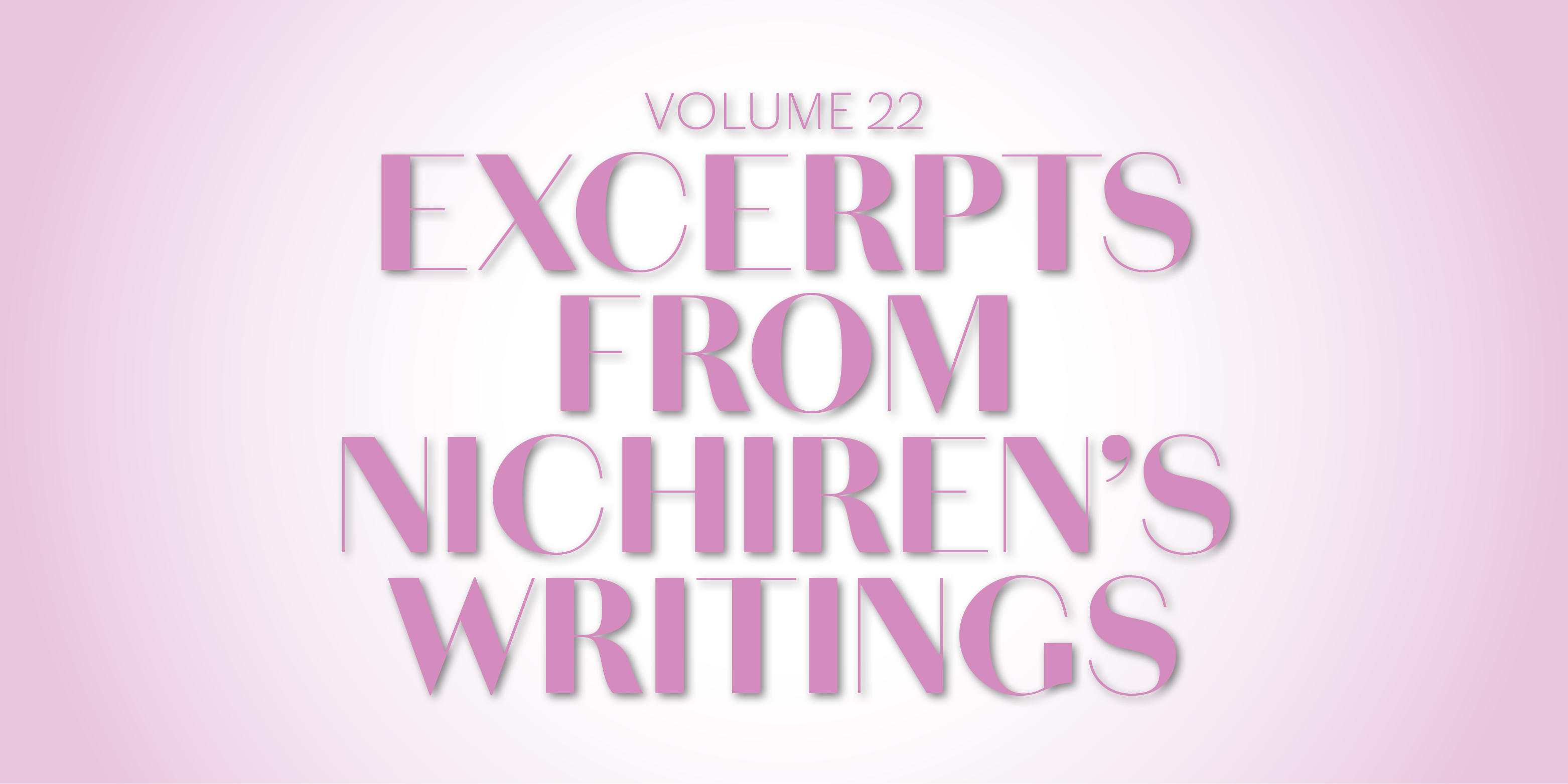This installment, published in the August 19, 2020, issue of the Seikyo Shimbun, focuses on passages from Nichiren Daishonin’s writings that Ikeda Sensei discusses in volume 22 of The New Human Revolution.
Passage 1
“If you are of the same mind as Nichiren, you must be a Bodhisattva of the Earth.” (“The True Aspect of All Phenomena,” The Writings of Nichiren Daishonin, vol. 1, p. 385)
Live Out the Great Vow for Kosen-rufu

Illustration courtesy of Seikyo Press.
At the 3rd General Meeting of the Five Year Group, Shin’ichi Yamamoto talked about the essence of the mentor-disciple relationship.
Shin’ichi Yamamoto remarked: “Being of ‘the same mind as Nichiren’ is the essence of our Buddhist faith and practice. The Soka mentors and disciples, starting with the founding president, Tsunesaburo Makiguchi, and his disciple and second president, Josei Toda, have dedicated their lives to carrying out the great vow for kosen-rufu in complete accord with the Daishonin’s spirit.
“Remaining true to the path of Soka mentor and disciple, therefore, is the practice of being of the same mind as Nichiren. Concretely speaking, this means keeping our mentor firmly in our heart at all times. …
During World War II, both Mr. Makiguchi and Mr. Toda were imprisoned as a result of their persecution by Japan’s military authorities, who conducted the war based on the ideology of State Shinto. …
Mr. Toda courageously followed his mentor, who was striving to achieve kosen-rufu just as the Daishonin instructed. That is the practice of being of the “same mind as Nichiren” in the present day and age. …
By standing up with the same spirit and resolve as his mentor, Mr. Toda awakened to his personal mission as a Bodhisattva of the Earth.
While referring to the profound ties shared by Mr. Makiguchi and Mr. Toda, Shin’ichi said to the young members of the Five Year Group: “I also awakened to my mission as a Bodhisattva of the Earth through serving and protecting Mr. Toda and struggling alongside him for kosen-rufu. This mentor-disciple bond is the lifeline that runs through the faith and practice of the Soka Gakkai. I hope that you will also remain true to the path of mentor and disciple all your lives, awaken to the noble mission with which you were born into this world, and lead bold and indomitable lives.” (The New Human Revolution, vol. 22, pp. 188–90)
Passage 2
“It is like grinding up a hundred medicinal plants to make a pill, or to make a hundred pills. Whether it be used for one pill or a hundred, the medicine will have the power to cure sickness.” (“The Pure and Far-Reaching Voice,” WND-1, 332)
The Soka Gakkai Exists Within Each of Us

Illustration courtesy of Seikyo Press.
On November 9, 1975, Shin’ichi Yamamoto attended the 38th Soka Gakkai Headquarters General Meeting held in Hiroshima, where he spoke about having awareness of our mission for kosen-rufu.
Shin’ichi Yamamoto said: “Each of you is the Soka Gakkai in its entirety. Please be assured that the Soka Gakkai can exist in no other form. Nichiren Buddhism teaches that each individual is qualified and possesses that noble mission.”
Each of us is the Soka Gakkai, and our relations with the members around us and our groups and districts are the Soka Gakkai, too. That is why kosen-rufu advances to the extent that we develop ourselves and strive our hardest for the sake of others and society. The Soka Gakkai can only triumph when each of us stands up and triumphs personally.
In social organizations, the individual is liable to be subsumed within the group. But the Soka Gakkai is a humanistic organization based on unity in diversity, striving to enable each individual to realize their fullest potential and personality. The purpose of the organization is to further kosen-rufu. It is a lofty effort to firmly establish a philosophy of the value of life in each person, and to protect human dignity and allow one’s individuality to shine.
We are not merely individual cogs within an organization; each of us possesses the Soka Gakkai within us that can serve as a source of pride and courage, and a guiding principle for our lives. In other words, the strength of the Soka Gakkai derives from the fact that it exists within each of us as individuals, deeply rooted in our innermost beings. (NHR-22, 333–34)
The Spirit to Start Anew
In November 1967, historian Arnold J. Toynbee met with Japanese industrialist and founder of Panasonic, Konosuke Matsushita.
At that meeting, Dr. Toynbee asked, “Who is the most important person for Japan’s future?”
Mr. Matsushita named Ikeda Sensei.
A month prior to this, Mr. Matsushita first met Sensei at the Tokyo Culture Festival hosted by the Soka Gakkai. While impressed by the event staff’s sincerity and the flawless performances, he was most deeply moved by Sensei’s heartfelt consideration.
Although Sensei could not speak directly to Mr. Matsushita at the event, he sent a Soka Gakkai leader over to thank him and ask whether he needed anything.
Mr. Matsushita recalled that, with 100,000 event staff and performers, as well as several thousand guests, Sensei “was incredibly busy, so I was surprised by the great hospitality he showed me” (The New Human Revolution, vol. 22, p. 60).
Sensei writes: “Each encounter with another person is a priceless opportunity. Interacting with people entails an earnest struggle waged with sincerity and integrity” (NHR-22, 60).
On January 2, 1988, Mr. Matsushita sent a message celebrating Sensei’s 60th birthday, which read in part: “Please regard today as the start of a period of even greater and more fulfilling activity. I pray that you will enjoy lasting good health and strive with the spirit as if to create another Soka Gakkai all over again” (NHR-22, 84).
Last month, on October 2, we commemorated the 60th anniversary of Sensei’s first overseas visit and the start of the global kosen-rufu movement. Let’s continue to refresh our vow to make even greater efforts for peace in the world as we strive to write new pages in the history of our own communities.
You are reading {{ meterCount }} of {{ meterMax }} free premium articles

